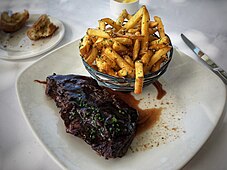 Steak frites | |
| Type | Meat |
|---|---|
| Course | Main course |
| Place of origin | Belgium, France |
| Serving temperature | Hot |
| Main ingredients | Steak, French fries, various sauces |
| Part of a series on |
| Steak |
|---|
Steak frites,[a] meaning "steak [and] fries" in French, is a dish consisting of steak paired with French fries. It is commonly served in European brasseries, and is considered by some to be the national dish of Belgium, which claims to be the place of its invention.[1]
Historically, the rump steak was commonly used for this dish. Today, more commonly, the steak is an entrecôte also called rib eye, or scotch fillet (in Australia), pan-fried rare ("saignant"—literally "bloody"), in a pan reduction sauce, sometimes with hollandaise or béarnaise sauce, served with deep-fried potatoes (French fries).[2][3]
Steak frites is also common in other countries, such as Anglophone and Spanish-speaking Latin American countries.
Steak frites is the subject of a semiotic analysis by the French cultural theorist Roland Barthes in his 1957 work Mythologies.[4]
-
Steak frites prepared using flank steak, at a San Francisco restaurant
-
Steak frites in Fontainebleau, France
See also[edit]
Notes[edit]
- ^ "Steak-frites" is also known by a variety of other names in French, such as "Bifteck-frites"; all with roughly the same meaning in translation.
References[edit]
- ^ Schehr, Lawrence R.; Weiss, Allen S. (2001). French Food: On the Table On the Page and in French Culture. Abingdon: Routledge. p. 158. ISBN 0415936284.
- ^ Bourdain, Anthony; Jose de Meirelles; Philippe Lajaunie (2004). Anthony Bourdain's Les Halles cookbook: strategies, recipes, and techniques of Classic Bistro Cooking. New York, NY: Bloomsbury. pp. 120 & 137. ISBN 978-1-58234-180-4. Retrieved 3 January 2012.
- ^ Beeton, Isabella Mary (1888). The Book of Household Management. London & New York: Ward, Lock & Company. p. 770. Retrieved 3 January 2012.
steak frites.
- ^ Barthes, Roland (1972). Mythologies. Translated by Lavers, Annette. New York: Hill and Wang. pp. 62–64. ISBN 978-0-374-52150-9.


Well, that’s interesting to know that Psilotum nudum are known as whisk ferns. Psilotum nudum is the commoner species of the two. While the P. flaccidum is a rare species and is found in the tropical islands. Both the species are usually epiphytic in habit and grow upon tree ferns. These species may also be terrestrial and grow in humus or in the crevices of the rocks.
View the detailed Guide of Psilotum nudum: Detailed Study Of Psilotum Nudum (Whisk Fern), Classification, Anatomy, Reproduction